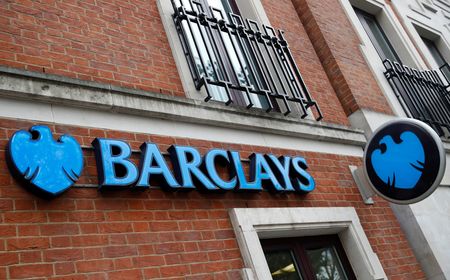By Simon Jessop and Lawrence White
LONDON (Reuters) – British investment bank Barclays has increased its sustainable and transition finance target to $1 trillion by 2030 as part of efforts to accelerate the shift to a low-carbon economy, its head of sustainable investment told Reuters.
The move sees Barclays catch up with rival HSBC, which said in 2020 it aims to contribute up to $1 trillion to companies to help them transition, and JPMorgan which has set a $2.5 trillion of sustainable funding target by 2030.
Barclays’ new target, which will fund everything from renewable energy and green mortgages to affordable housing, marks a more than five-fold increase from the bank’s previous financing goal of $150 billion by 2025.
Banks’ climate efforts are increasingly in the spotlight, with campaigners and politicians alike raising concern the industry is not doing enough to manage the risks of global warming and help the real economy transition to cleaner energy.
Earlier this year, U.N. climate scientists warned the world was running out of time to cap the global temperature rise at 1.5 degrees Celsius above the pre-industrial average, and recent climate talks confirmed finance was not moving quick enough.
Barclays, which had assets totalling 1.7 trillion pounds ($2.1 trillion) as of Sept. 30, will count financing it helps companies raise in the debt and equity capital markets, so-called ‘facilitated’ finance as well as direct lending, towards the $1 trillion total.
Climate activist groups have criticised such targets for being outside the scope of formal regulatory scrutiny and too broad in what they count towards the total, although Barclays will report on its progress and can be judged by its investors.
In addition, Barclays also said it would increase the amount of its own capital it invests in climate start-ups through its Sustainable Impact Capital initiative to 500 million pounds by 2027, from 175 million pounds by 2025.
“We are helping to drive the transition and drive financing to where it’s really needed, both to decarbonise high-emitting sectors and to scale up the next wave of climate technologies that are going to be required to decarbonise industries and create green jobs,” said the bank’s global head of sustainable finance, Daniel Hanna.
Hanna joined Barclays from a similar position at Standard Chartered earlier this year.
As a member of the Net Zero Banking Alliance, an industry group aiming to cut the emissions tied to their financing, Barclays has already set out targets for several high-emitting sectors including energy, power and steel.
In March, Barclays warned the Ukraine conflict could hamper its ability to hit its carbon emissions-reduction targets, and went on to face protests from activists over its lending to the fossil fuel industry at its annual meeting.
Despite the protests, Barclays’ climate strategy was backed by 80.8% of the votes cast by shareholders.
Barclays was the 7th biggest lender to the fossil fuel industry between 2016 and 2021, the most active among European banks, according to a report by activist group Rainforest Action Network and others, published in March this year.
Some banks have disputed the calculations in the report, which did note that Barclays’ financing was on a downward trend, with $19 billion worth of funding in 2021, down from $28 billion the year before.
($1 = 0.8087 pounds)
(Reporting by Simon Jessop and Lawrence White; Editing by Lincoln Feast.)

